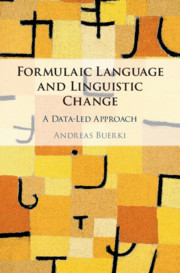Book contents
- Frontmatter
- Dedication
- Contents
- List of Figures
- List of Tables
- Preface
- Abbreviations
- Introduction
- 1 Formulaic Language
- 2 Cultural Context and Diachrony
- 3 The Data, the Community and a Data-Led Identification of MWEs
- 4 MWEs in Written German
- 5 Culture As Motivator of Change
- 6 Cultural Motivation in Context
- Conclusions
- Appendix A Filter Entries
- Appendix B Rater Guidelines on Semantic Unity
- References
- Index
2 - Cultural Context and Diachrony
Published online by Cambridge University Press: 06 April 2020
- Frontmatter
- Dedication
- Contents
- List of Figures
- List of Tables
- Preface
- Abbreviations
- Introduction
- 1 Formulaic Language
- 2 Cultural Context and Diachrony
- 3 The Data, the Community and a Data-Led Identification of MWEs
- 4 MWEs in Written German
- 5 Culture As Motivator of Change
- 6 Cultural Motivation in Context
- Conclusions
- Appendix A Filter Entries
- Appendix B Rater Guidelines on Semantic Unity
- References
- Index
Summary
In Chapter 2, it is argued that a diachronic perspective on the connection between culture and formulaic language is a useful one. The first half of the chapter looks at how linguistic change, and change in formulaic language in particular, has been understood (and misunderstood) in previous research. The thorny issue of what motivates linguistic change, which is key to the analyses presented in later chapters, is also addressed. In the second half of the chapter, the reader is introduced to ways in which culture and society have been understood and the comprehensive understanding of these concepts, as employed in the present work, is developed and presented. Previous research on the relation between language and culture is then drawn upon and worked into the conceptualisation of this relation proposed in the book.
Keywords
- Type
- Chapter
- Information
- Formulaic Language and Linguistic ChangeA Data-Led Approach, pp. 32 - 69Publisher: Cambridge University PressPrint publication year: 2020

